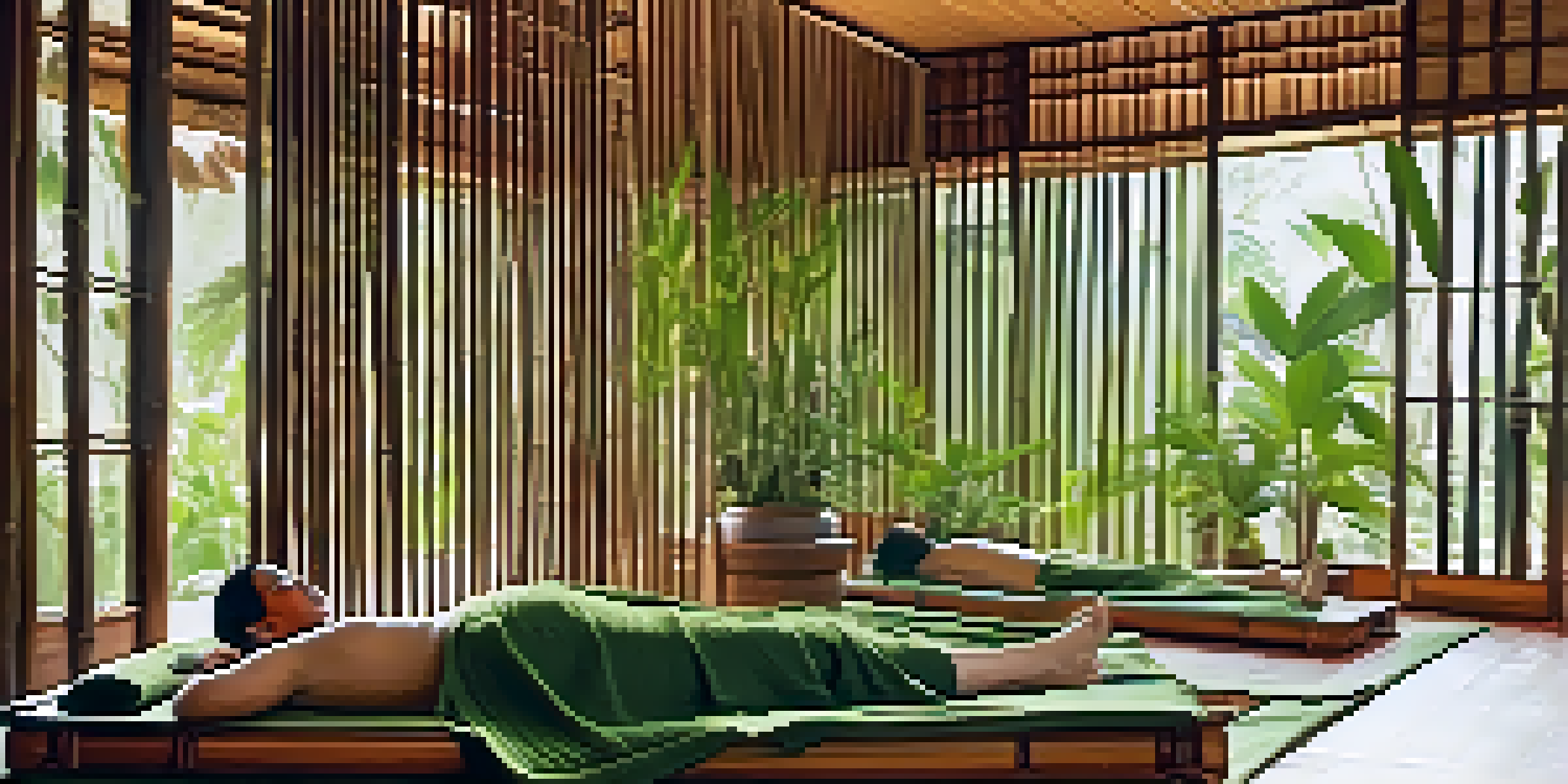Key Techniques of Thai Massage: A Comprehensive Overview

Understanding the Essence of Thai Massage Techniques
Thai massage is an ancient practice that combines acupressure, yoga, and reflexology. It focuses on the body’s energy lines, known as 'Sen,' believed to affect physical and emotional well-being. This holistic approach not only soothes sore muscles but also revitalizes the mind and spirit, creating a harmonious balance.
Massage is not just a luxury. It's a way to a healthier, happier life.
What sets Thai massage apart is its unique blend of stretching and rhythmic compressions. Practitioners use their hands, elbows, knees, and feet to apply pressure and stretch the recipient's body. This dynamic interplay allows for a deeply relaxing experience that enhances flexibility and alleviates tension.
Moreover, the importance of breath in Thai massage cannot be overstated. Both the practitioner and the recipient are encouraged to synchronize their breathing during the session, which fosters a deeper connection and enhances relaxation. Understanding these foundational elements prepares us for a deeper dive into specific techniques.
The Role of Stretching in Thai Massage
One of the hallmark techniques of Thai massage is its emphasis on stretching. These stretches are often compared to yoga poses, where the therapist guides the client into various positions to improve flexibility. This not only helps relieve tension but also increases the range of motion in joints, leading to overall better physical health.

Stretching in Thai massage is both therapeutic and invigorating. For instance, a common stretch involves pulling the legs gently while keeping the back straight, which can relieve lower back pain and improve posture. Many clients leave feeling not only relaxed but also more limber and agile.
Holistic Benefits of Thai Massage
Thai massage combines stretching, pressure, and breath work to enhance physical and emotional well-being.
Incorporating these stretches into the massage routine also helps stimulate blood circulation. Enhanced circulation contributes to the healing process by delivering oxygen and nutrients to the muscles. This technique is not just about relaxation; it's about revitalizing the body.
The Use of Pressure and Acupressure Points
Pressure application is another key component of Thai massage, often targeting specific acupressure points throughout the body. By applying sustained pressure on these points, practitioners can help release blockages in energy flow, alleviating pain and discomfort. This technique draws heavily from traditional Chinese medicine principles.
The body achieves what the mind believes.
For example, pressure on the foot's reflex points can trigger responses in corresponding organs, promoting overall health. Many clients report feeling a rush of energy or a profound sense of relief after these targeted applications. It's a fascinating interplay between modern bodily understanding and age-old practices.
Moreover, the pressure is not always intense; it can be adjusted according to the client's comfort level. This adaptability makes Thai massage accessible to individuals of all ages and fitness levels, ensuring everyone can benefit from its healing properties.
Incorporating Breath Work into Thai Massage
Breath work is integral to the experience of Thai massage, enhancing relaxation and deepening the overall therapeutic effect. Practitioners often encourage clients to breathe deeply and rhythmically, synchronizing their breath with the movements and pressure applied during the session. This practice not only calms the mind but also aids in releasing physical tension.
As you breathe deeply, your body naturally relaxes, making it easier for the therapist to work through tight areas. Clients often describe feeling lighter and more at ease with each breath, as they let go of stress and anxiety. It’s like a gentle reminder that sometimes, all we need to do is breathe.
Importance of Client Communication
Effective communication between the client and therapist ensures a personalized and comfortable massage experience.
Furthermore, conscious breathing can enhance the flow of energy throughout the body. As energy moves freely, clients may experience a sense of rejuvenation, making breath work a vital technique in Thai massage. It’s this holistic approach that makes each session feel transformative.
The Flow of the Session: Rhythm and Movement
Thai massage is characterized by its fluidity and rhythm, which create a soothing experience for clients. The practitioner moves gracefully from one technique to another, almost like a dance. This fluidity not only captivates the senses but also fosters a sense of trust and comfort.
The rhythmic movements help clients feel more at ease, allowing them to relax and surrender to the experience. For instance, the combination of gentle rocking and stretching can mimic the sensation of being cradled, which many find calming. This unique flow enhances the overall effectiveness of the massage.
Moreover, this seamless transition between techniques encourages a deeper connection between the therapist and client. As the therapist tunes into the client’s body language and breath, they can adjust their approach, ensuring a personalized experience. This emphasis on rhythm and movement is what makes Thai massage truly special.
The Importance of Client-Therapist Communication
Effective communication between the client and therapist is essential for a successful Thai massage session. Before beginning, therapists typically ask about any areas of discomfort or specific needs, allowing for a tailored experience. This dialogue helps the practitioner understand the client’s body and preferences, ensuring they receive the best care possible.
During the session, clients are encouraged to express their comfort levels and any sensations they’re experiencing. This feedback is invaluable; it helps the therapist adjust techniques and pressures to maintain a positive experience. After all, the goal is to create an environment where clients feel safe and cared for.
Regular Sessions Enhance Wellness
Consistent Thai massage leads to improved flexibility, reduced tension, and better mental clarity.
Post-session communication is equally important, as therapists may offer insights or recommendations for further self-care. This holistic approach underscores the idea that Thai massage is not just about the session itself, but about fostering long-term well-being. It's a relationship built on trust and understanding.
The Benefits of Regular Thai Massage
Regular Thai massage sessions can lead to numerous physical and mental health benefits. Many clients report improved flexibility, reduced muscle tension, and enhanced energy levels after consistent treatments. This cumulative effect is what makes Thai massage a valuable addition to anyone's wellness routine.
Moreover, beyond the physical benefits, many find that regular sessions help manage stress and anxiety. The combination of deep relaxation, improved circulation, and mindful breathing creates a sense of mental clarity and emotional balance. It’s not just a treat for the body, but a nourishing experience for the mind.

Incorporating Thai massage into your lifestyle can also promote better sleep patterns and overall health. As you restore balance to your body, you may find that your sleep improves, allowing you to wake up feeling rejuvenated. This holistic approach to health is what makes Thai massage a timeless practice.